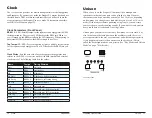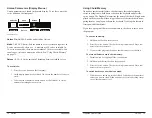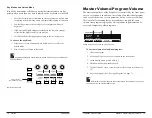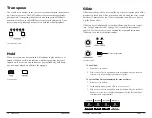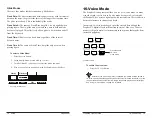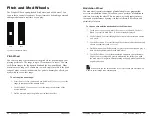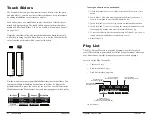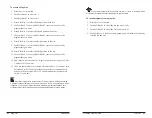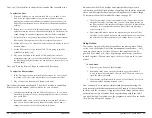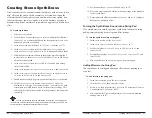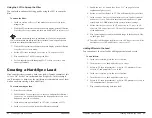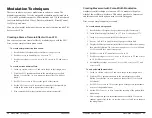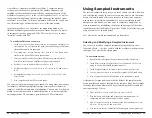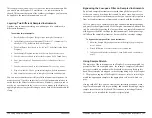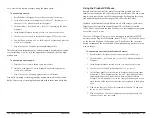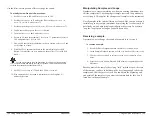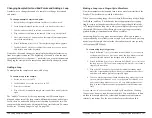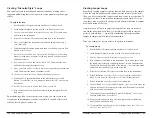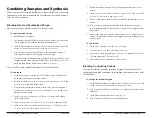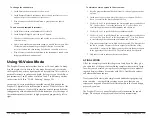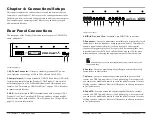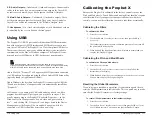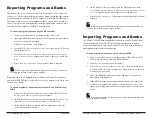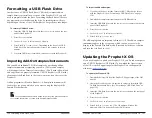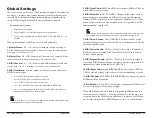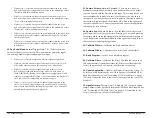
98
99
Modulation Techniques
Sequential
Prophet X User’s Guide
Using Sampled Instruments
As oscillator 1 frequency-modulates oscillator 2, complex harmon-
ics known as
sidebands
are generated. The number, frequency, and
amplitude of the sidebands are controlled by changing the ratio of the
modulator
frequency (osc 1) to the
carrier
frequency (osc 2), as well as
the amount of modulation. In other words, changing the pitch of either
oscillator 1 or oscillator 2 will have a dramatic effects on the sound, and
so will increasing or decreasing the
amount
in the mod matrix.
In the example above, as you increase the modulation amount, the
sideband harmonics generated are more non-linear, like those in metal-
lic instruments such as gongs and bells. This is why it’s easy to create
“metallic” sounds with FM.
To modify the FM sound even more:
1. In the
oscillators
section, slowly turn the
pitch
knob on Oscillator 1 to
raise its pitch. As you increase the pitch, the sound changes as different
sideband harmonics are generated.
2. Try setting Osc 1
pitch
to F#6 and Osc 2
pitch
to C3. The sound is now
similar to the classic FM electric piano sound.
3. To make it really sound like a classic FM electric piano, adjust the
filter, filter envelope, and amplifier envelopes appropriately:
4.
Set filter
cutoff
to 0 and set filter
env
amount
to 91.
5.
Set filter envelope
attack
to 0,
decay
to 98,
sustain
to 32, and
release
to 90.
6.
Set amplifier envelope
attack
to 0,
decay
to 84,
sustain
to 127, and
release
to 80.
7. Play some chords. Basic FM electric piano!
You can create much more aggressive sounds by using other waveshapes
(or samples), different tuning relationships between the oscillators (or
samples), and different amounts of modulation. You can also use the mod
matrix to route both oscillators and both samples to each other in differ-
ent configurations. The harmonic possibilities of FM are immense.
Using Sampled Instruments
The internal sample library gives you a lot of variety to work with when
you’re designing sounds. In some cases you may want to use the instru-
ments as is, and just add effects as necessary. In other cases you may
want to layer two different instruments to create something new and
unexpected. And finally, you may want to completely mangle one or
more instruments by modulating their loops and using all of the other
synth functions that the Prophet X provides. With a bit of creativity, you
can go to some very extreme places.
Let’s start with a simple instrument and go from there.
Selecting and Modifying a Sampled Instrument
You can easily modify a sampled instrument using the filters, enve
-
lopes and effects — just like you did with the oscillators in the previous
examples. Let’s start with a simple piano.
To customize a piano:
1. Recall the Basic Program. (See previous examples if necessary.)
2. In the Mixer section, turn Oscillator 1 level down to 0. (We’re just
going to work with sampled instruments here.)
3. In the Sample Playback section use the
type
knob to select
piano
.
4. Use the
instrument
knob to select the first piano (1928 Grand Near).
5. Play a few notes and chords and listen to the instrument’s sound.
At this point it’s important to note that by default, the sampled instru-
ments pass through and are affected by the low-pass filter. So it’s simple
to change their sound dramatically by just adjusting the filter and filter
envelope settings. Like so:
6.
Next, set filter
cutoff
to 0 and filter
env
amount
to 120.
7. Play few notes and chords and listen to the instrument now. It’s
completely different and unrecognizable as a piano.
8.
Now, set filter
resonance
to 160 and set the filter envelope to
attack
60,
decay
60,
sustain
45, and
release
40.
9. Play few more chords. Completely different again and un-piano-like.

